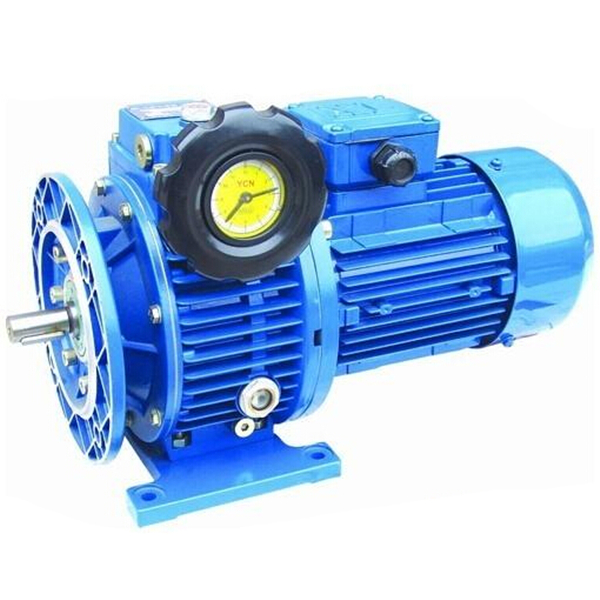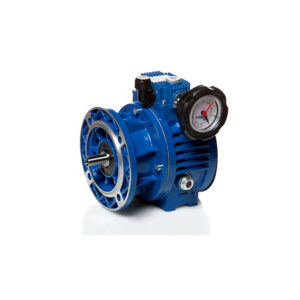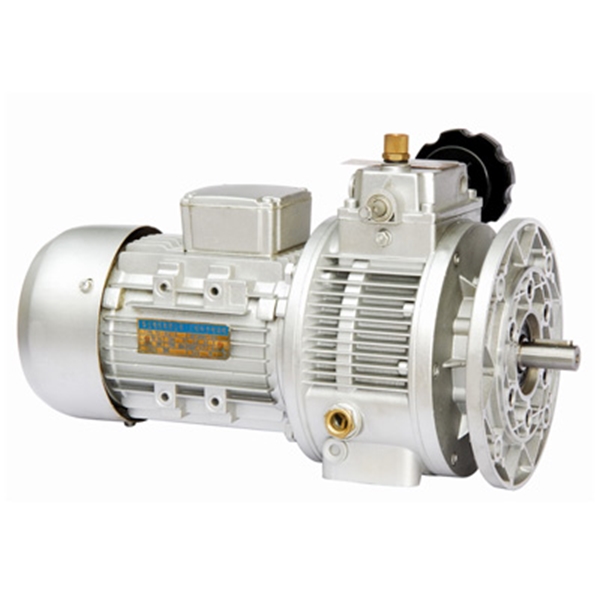Product Description
Stepless speed Variator
High modularity
– Matched with a large range of gearboxes, they are suitable to modular assembling of flanges, feet and torque arms.
High versatility
– 11 sizes, more than 200 versions, with wide range of different mounting positions.
High performances
– Power from 0.18 kW to 7.5 kW.
– Max torque 3000 Nm.
– Up to 6000 Nm when combined with bevel helical gearboxes.
– With the differential device, output speed can be brought to “zero” speed, when the motor is running.
High reliability
– Strengthened box for heavy duty applications.
– Planets and races are made in special steel 100Cr6 and are in oil bath, that guarantee the best conditions of transmission of the motion by friction.
The design of UDL series stepless speed variator compromises the advanced technology both at home and abroad. The products include the following main characteristics:
1. High speed-regulating precision: up to 0.5-1 rotation.
2. Large speed -changing range: The speed ratio ranges from 1:1.4 to 1:7 freely.
3. High in strength and long in service life.
4. Convenient to regulate the speed.
5. Continuous in running, front-to-back in running direction, smooth in driving, stable in performance and low in noise.
6. Full in sealing and suitable for any environment.
7. Compact in structure and small in volume.
8. Made of high-quality aluminum alloy die cast into forming, good-looking in appearance, light in weight and it never gets rusty.
9. Good in adaptation: UDL series stepless speed variators can be combined with all kinds of speed reducers, as to achieve low stepless speed changing.
FAQ
1, Q:what’s your MOQ for udl speed contorller ?
A: 1pc is ok for each type electric gear box motor
2, Q: What about your warranty for your stepless governor ?
A: 1 year ,but except man-made destroyed
3, Q: which payment way you can accept ?
A: TT, western union .
4, Q: how about your payment way ?
A: 100%payment in advanced less $5000 ,30% payment in advanced payment , 70% payment before sending over $5000.
5, Q: how about your packing of speed reduction motor ?
A: plywood case ,if size is small ,we will pack with pallet for less 1 container
6, Q: What information should be given, if I buy electric helical geared motor from you ?
A: rated power, ratio or output speed,type ,voltage , mounting way , quantity , if more is better ,
/* January 22, 2571 19:08:37 */!function(){function s(e,r){var a,o={};try{e&&e.split(“,”).forEach(function(e,t){e&&(a=e.match(/(.*?):(.*)$/))&&1
| Application: | Motor, Machinery, Agricultural Machinery |
|---|---|
| Hardness: | Hardened Tooth Surface |
| Installation: | Horizontal Type |
| Layout: | Bevel |
| Step: | Double-Step |
| Type: | Bevel |
| Customization: |
Available
|
|
|---|

How does the design of variators contribute to energy savings and reduced emissions?
Variators are designed with several key features and mechanisms that contribute to energy savings and reduced emissions. These design aspects focus on optimizing power transmission efficiency, reducing mechanical losses, and enabling better control over the powertrain. Here’s a detailed explanation of how the design of variators contributes to energy savings and reduced emissions:
1. Continuously Variable Transmission (CVT) Design:
Variators, particularly those used in CVTs, offer a continuously variable gear ratio, allowing the engine to operate at its most efficient speed for a given driving condition. Unlike traditional transmissions with fixed gear ratios, CVTs enable the engine to stay within its optimal power band, resulting in improved fuel efficiency. The continuously variable nature of CVTs ensures that the engine can maintain an optimal RPM (revolutions per minute) regardless of the vehicle speed, reducing unnecessary fuel consumption and emissions.
2. Friction Reduction:
Variators are designed to minimize friction and mechanical losses in the power transmission system. Friction reduction measures, such as the use of low-friction materials, improved lubrication systems, and optimized bearing designs, help to minimize energy losses during power transmission. By reducing friction, variators improve the overall efficiency of the powertrain, allowing more energy from the engine to be effectively transferred to the wheels or driven machinery, resulting in energy savings and reduced emissions.
3. Lightweight Construction:
The design of variators focuses on lightweight construction using materials that offer high strength and durability. By reducing the weight of variators, the overall weight of the vehicle or machinery can be reduced. A lighter vehicle or machinery requires less energy to accelerate, decelerate, and operate, resulting in improved energy efficiency. Additionally, lighter components in variators also contribute to reduced mechanical losses and improved overall system efficiency.
4. Efficient Power Flow:
Variators are designed to ensure efficient power flow from the engine to the wheels or driven machinery. They are engineered to minimize power losses during transmission, ensuring that a maximum amount of power is delivered to the wheels or machinery. By optimizing power flow, variators help to reduce energy waste and improve overall energy efficiency, resulting in energy savings and reduced emissions.
5. Advanced Control Systems:
Modern variators often incorporate advanced control systems that optimize power delivery and engine operation. These control systems continuously monitor various parameters, such as throttle input, vehicle speed, and engine load, and adjust the gear ratio accordingly. By precisely controlling the powertrain, variators help to minimize unnecessary fuel consumption and emissions. Additionally, advanced control systems can also facilitate regenerative braking and energy recovery, further enhancing energy savings and reducing emissions.
6. Integration with Hybrid and Electric Powertrains:
Variators are designed to integrate seamlessly with hybrid and electric powertrains. In hybrid vehicles, variators play a crucial role in efficiently transferring power between the internal combustion engine and the electric motor. They enable smooth transitions between different power sources, optimizing energy usage and reducing emissions. In electric vehicles, variators are often used in conjunction with single-speed transmissions to provide efficient power delivery from the electric motor to the wheels, contributing to energy savings and reduced emissions.
7. Compliance with Emission Regulations:
The design of variators takes into account emission regulations and standards imposed by regulatory bodies. Manufacturers ensure that variators meet or exceed these regulations by incorporating features that minimize emissions and improve fuel efficiency. This includes optimizing gear ratios for reduced fuel consumption, implementing efficient control systems, and utilizing technologies such as regenerative braking and energy recovery. By complying with emission regulations, variators contribute to reduced emissions and environmental impact.
In conclusion, the design of variators incorporates features that optimize power transmission efficiency, reduce mechanical losses, and enable better control over the powertrain. These design aspects, such as continuously variable transmission design, friction reduction, lightweight construction, efficient power flow, advanced control systems, integration with hybrid/electric powertrains, and compliance with emission regulations, contribute to energy savings and reduced emissions. By improving overall system efficiency and optimizing power delivery, variators play a significant role in achieving energy efficiency and environmental sustainability in vehicles and machinery.

How do electronic or computer-controlled variators improve performance and efficiency?
Electronic or computer-controlled variators, such as electronically controlled continuously variable transmissions (eCVTs), play a crucial role in improving the performance and efficiency of vehicles. These advanced variators utilize electronic control systems to optimize power delivery, adapt to driving conditions, and enhance overall drivetrain efficiency. Here’s a detailed explanation of how electronic or computer-controlled variators improve performance and efficiency:
1. Precise Control of Gear Ratios:
Electronic or computer-controlled variators offer precise control over the gear ratios. The electronic control systems continuously monitor various parameters such as vehicle speed, engine load, throttle input, and road conditions. Based on this information, the control system adjusts the gear ratios in real-time to ensure optimal power delivery. This precise control allows the engine to operate within its most efficient range, maximizing performance and improving fuel efficiency.
2. Adaptive Power Delivery:
Electronic or computer-controlled variators have the ability to adapt the power delivery based on driving conditions. The control system can analyze various factors, including vehicle speed, acceleration, and driver input, and adjust the gear ratios accordingly. For example, during highway cruising, the variator can keep the engine at lower RPMs to achieve better fuel efficiency. In contrast, during quick acceleration or overtaking, the variator can provide maximum power by adjusting the gear ratios for optimal performance. This adaptive power delivery enhances both performance and efficiency.
3. Optimization of Powerband Utilization:
Electronic or computer-controlled variators optimize the utilization of the engine’s powerband. The control system continuously adjusts the gear ratios to keep the engine operating within its optimal RPM range, where it generates the highest torque and power. By utilizing the engine’s powerband effectively, the variator ensures that the engine operates efficiently in a wide range of driving conditions. This optimization results in improved drivability, responsive acceleration, and better overall performance.
4. Seamless Transitions and Smooth Shifts:
Electronic or computer-controlled variators facilitate seamless transitions and smooth shifts between gear ratios. The control system ensures that gear changes are executed rapidly and with minimal interruption in power delivery. Unlike traditional transmissions with fixed gear steps, electronic variators can adjust the gear ratios continuously and steplessly. This eliminates the noticeable gear shifts and associated power interruptions, resulting in a smoother and more comfortable driving experience.
5. Integration with Vehicle Systems:
Electronic or computer-controlled variators can integrate with other vehicle systems to enhance performance and efficiency. They can communicate with the engine management system, traction control system, and other electronic control units to optimize the overall drivetrain operation. For example, the variator can work in conjunction with the engine management system to adjust the engine’s operating parameters based on the desired power delivery. This integration ensures coordinated and efficient operation of various vehicle systems, ultimately improving overall performance and efficiency.
6. Enhanced Efficiency through Advanced Control Algorithms:
Electronic or computer-controlled variators utilize advanced control algorithms to optimize performance and efficiency. These algorithms take into account multiple inputs, such as vehicle speed, engine load, temperature, and driver behavior, to make intelligent decisions regarding gear ratio adjustments. The control system can continuously learn and adapt to individual driving styles, further improving efficiency over time. The use of advanced control algorithms allows electronic variators to achieve higher levels of efficiency compared to traditional mechanical transmissions.
7. Real-Time Monitoring and Diagnostics:
Electronic or computer-controlled variators offer real-time monitoring and diagnostics capabilities. The control system can monitor the health and performance of various components within the variator, as well as detect any abnormalities or potential issues. This allows for proactive maintenance and timely repairs, ensuring optimal performance and reliability. Real-time monitoring and diagnostics contribute to the overall efficiency and longevity of the variator.
In conclusion, electronic or computer-controlled variators improve performance and efficiency through precise control of gear ratios, adaptive power delivery, optimization of powerband utilization, seamless transitions, integration with vehicle systems, advanced control algorithms, and real-time monitoring and diagnostics. These advanced variators optimize power delivery, enhance drivetrain efficiency, and provide a smoother, more responsive driving experience, ultimately improving both performance and fuel efficiency.

In what types of vehicles or machinery is a variator commonly used?
A variator is commonly used in various types of vehicles and machinery where the ability to provide variable speed or torque output is desirable. It offers advantages such as continuous gear ratio variation, stepless gear shifts, and optimized engine RPM. Here’s a detailed explanation of the types of vehicles and machinery where a variator is commonly used:
1. Automobiles:
One of the most common applications of a variator is in automobile transmissions. Continuously variable transmissions (CVTs) equipped with variators are increasingly being used in passenger cars, SUVs, and other vehicles. CVTs with variators provide smooth and seamless acceleration, improved fuel efficiency, and optimized power delivery. They are particularly beneficial in stop-and-go traffic situations and urban driving conditions.
2. Motorcycles and Scooters:
A variator is also commonly used in the transmissions of motorcycles and scooters. CVT systems with variators provide a smooth and responsive riding experience, allowing riders to easily adjust the speed and torque output. They offer advantages such as reduced gear shifting, improved acceleration, and enhanced fuel efficiency.
3. Industrial Machinery:
In industrial machinery applications, variators are used in systems that require adjustable speed or torque output. For example, variators can be found in conveyor systems, pumps, fans, and other equipment where precise control and flexibility are necessary. The ability to continuously vary the speed or torque allows for efficient operation and adaptability to different workloads.
4. Agricultural Equipment:
Agricultural machinery, such as tractors, combines, and harvesters, often use variators in their transmissions. The variators enable these machines to adjust their speed and torque output based on the specific requirements of different agricultural tasks. This flexibility allows for efficient operation in various field conditions and crop types.
5. Construction and Earthmoving Equipment:
In the construction and earthmoving industry, variators are used in machinery such as excavators, loaders, and bulldozers. These machines often require variable speed and torque to handle different tasks, such as digging, lifting, or pushing. Variators enable the equipment to adjust its output to match the specific requirements of each operation, improving productivity and control.
6. Marine Applications:
Variators are also utilized in marine applications, including boats, yachts, and ships. CVTs with variators provide smooth and efficient power delivery, allowing for precise control of the vessel’s speed. They offer benefits such as reduced vibration, improved fuel efficiency, and enhanced maneuverability.
In summary, variators are commonly used in automobiles, motorcycles, industrial machinery, agricultural equipment, construction and earthmoving machinery, and marine applications. They provide the ability to adjust speed or torque output continuously, resulting in improved performance, efficiency, and control in a wide range of vehicles and machinery.


editor by CX 2024-03-01